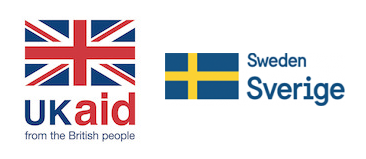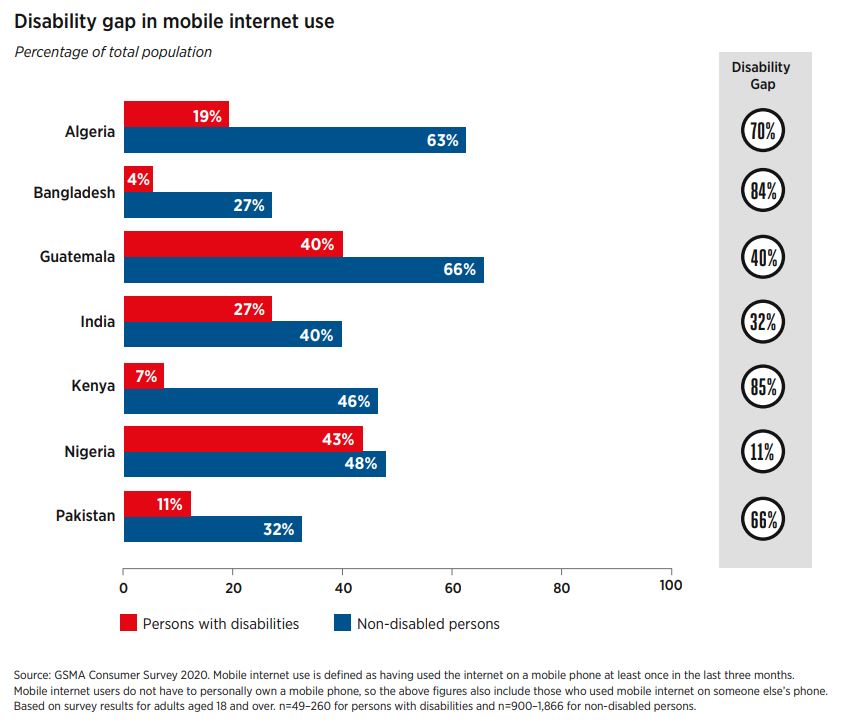Data on the digital inclusion of persons with disabilities in low and middle-income countries (LMICs) is often scarce and unreliable. The GSMA Assistive Tech programme has been working to address this gap, specifically focusing on understanding access and use of mobile products and services by persons with disabilities.
Key learnings
This blog picks out five key learnings from three recent research reports: The Mobile Disability Gap Report 2021 covering seven LMICs and disability specific research in Sri Lanka and Ghana.
1. Mobiles play a key role in helping persons with disabilities to live independent lives and access basic services. In Ghana, our data shows that mobile adds significant value for persons with disabilities, enabling them to meet important life needs, including financial services. But fewer persons with disabilities find accessing basic services via mobile as helpful as non-disabled persons. Similarly, in Sri Lanka, a large portion of persons with disabilities find mobile plays an important role in enabling them to carry out a wide range of activities, but once again, fewer persons with disabilities perceive mobile as helpful in accessing basic services.
The data from both Sri Lanka and Ghana suggests that many persons with disabilities were unable to leverage mobile to access key services such as health, education, transportation, and employment during lockdowns and social distancing restrictions. This finding is important as it highlights how the transition to digital can further marginalise persons with disabilities and other underserved populations if nothing is done to ensure equitable access for everyone.
2. Persons with disabilities are less likely than non-disabled persons to own a mobile, especially a smartphone, and to be aware of or use mobile internet. In all countries covered by the research, we found a substantial mobile disability gap in ownership and use of mobile (Figure 1). In each country, the gap increased further for mobile internet use (Figure 2). This is a missed opportunity for persons with disabilities to reap the benefits of mobile internet and internet-enabled services and products to lead more independent lives.
Figure 1: The mobile disability gap in mobile ownership
Figure 2: The mobile disability gap in mobile internet use
3. Persons with disabilities are missing out on the benefits of smartphones as an assistive technology. Smartphones can cluster multiple assistive technologies into one device, enabling more autonomous living for persons with disabilities. However, despite their potential, across all countries surveyed, persons with disabilities are less likely to own a smartphone than non-disabled persons. Smartphone ownership also varies by disability type and country. For instance, in both Sri Lanka and Ghana, mobile owners with speech impairment had the highest level of smartphone ownership, albeit lower in Ghana. In Sri Lanka 78 per cent of those with a speech impairment reported owning a smartphone compared to 28 per cent in Ghana.
Figure 3: Types of handset owned by mobile owners with disabilities in Sri Lanka
4. Key barriers to using mobile for persons with disabilities include the disability itself, awareness of accessibility features, affordability and levels of literacy and skills. Accessibility features such as screen readers, text magnifiers, and object recognition are key tools for persons with disabilities and are built-in to most smartphones. However, awareness of these crucial features is low, and substantially lower than for non-disabled persons.
For example, in Ghana only 25 per cent of persons with disabilities are aware of video conferencing options and only 18 per cent know that text size can be magnified (Figure 4). Similarly, low levels of awareness were also found in Sri Lanka. Given that many persons with disabilities report that their condition prevents them from using mobile services or even owning a phone, such knowledge of accessibility features is critical for digital inclusion.
Encouragingly, our research shows that once persons with disabilities are aware of accessibility features, their usage of mobile-enabled services is high. Given that the use of accessibility features is high among non-disabled persons as well, this reinforces the value of these features for everyone.
Figure 4: Awareness of mobile accessibility feature among mobile users in Ghana
5. The intersection of disability and gender can have a compounding effect on digital exclusion. Our Consumer Survey data also analysed the intersectionality between disability and gender; with women with disabilities having lower levels of mobile ownership and mobile internet use than men with disabilities, and also non-disabled women. However, the importance of gender and disability varies between countries. For instance, in Guatemala disability is a stronger determinant of mobile use than gender, whereas in India gender is a stronger determinant. The research from Ghana and Sri Lanka also revealed that alongside gender, age, location and level of employment can further compound the mobile disability gap.
Key considerations for disability inclusive research
Our research highlights the following key considerations when conducting disability research:
Ensure persons with disabilities voices are heard: In-country research must be inclusive, accessible by all, considerate of disability needs, and ensure persons with disabilities’ voices are heard: “nothing about us, without us”. Involving people with disabilities and engaging with disabilities specialists and organisations for persons with disabilities in the research, including its design is important.
Disaggregate data by disability type: Our findings highlight the differences in ownership and use of mobile technologies between persons with and without disabilities as well as investigate the nuances between different disability types. It is essential to acknowledge that persons with disabilities are not a homogenous group. Collecting disability disaggregated data plays a significant role in our understanding of where citizens with disabilities are in their journey to be digital included, and towards the regular use of mobile internet. It highlights the barriers hindering different groups from participating in the digital world, and the digital economy.
Understand the local context: Our research highlights that levels of mobile ownership and use by persons with disabilities along with the barriers they face vary greatly depending on country and context. Beyond disability type, it is important that research considers other facets of the individual (gender, age, education level etc.) and their needs to understand how these characteristics intersect and impacts on access and use of mobile.
Collected and analyse both quantitative and qualitative data: To identify tangible actions needed to close the gap, both quantitative and qualitative data are needed, including participatory user research with persons with disabilities. By highlighting touch points where customers with disabilities interact with public or private service providers, such research can uncover important experiences, drivers and pain points to improve mobile related products and services, and enhance user experience.
For a full list of our Assistive Tech programme research, click here.

The Assistive Tech programme now sits under the Connected Society programme which is funded by the UK Foreign, Commonwealth & Development Office (FCDO) and the Swedish International Development Cooperation Agency (SIDA), and is supported by the GSMA and its members.







